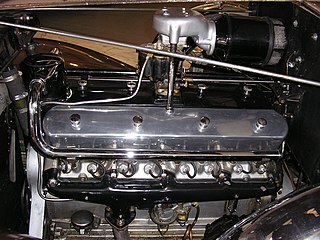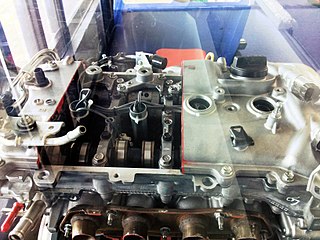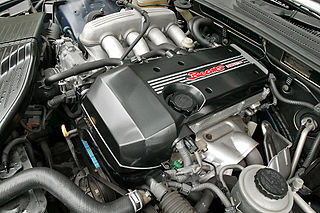Related Research Articles

A V16 engine is a V engine with 16 cylinders. Engines of this number of cylinders are uncommon in automotive use.

VVT-i, or Variable Valve Timing with intelligence, is an automobile variable valve timing technology developed by Toyota. The Toyota VVT-i system replaces the Toyota VVT offered starting in 1991 on the 5-valve per cylinder 4A-GE engine. The VVT system is a 2-stage hydraulically controlled cam phasing system.

The Ford Small Block is a series of automobile V8 engines built by the Ford Motor Company beginning in July 1961. The engine was discontinued in new trucks (F-Series) after 1996, and new SUVs (Explorer) after 2001, but remains available for purchase from Ford Racing and Performance Parts as a crate engine. The "Windsor" designation is a retroactive applied for the family of engines sharing a common basic engine block design. The Windsor designation was adopted to distinguish the 351 cu in (5.8 L) version from the Cleveland 335-family engine that had the same displacement, but a significantly different configuration. The designations of 'Windsor' and 'Cleveland' were derived from the locations of manufacture: Windsor, Ontario and Cleveland, Ohio.

The Chevrolet small-block engine is a series of V8 automobile engines used in normal production by the Chevrolet Division of General Motors between 1955 and 2003, using the same basic engine block. Referred to as a "small block" for its comparative size relative to the physically much larger Chevrolet big-block engines, the family spanned from 262 cu in (4.3 L) to 400 cu in (6.6 L) in displacement.

The BMW E30 is the second generation of BMW 3 Series, which was produced from 1982-1994 and replaced the E21 3 Series.

The A Series engines are a family of inline-four internal combustion engines with displacement from 1.3 L to 1.8 L produced by Toyota Motor Corporation. The series has cast iron engine blocks and aluminum cylinder heads. To make the engine as short as possible, the cylinders are siamesed. The 1A engine was only 550 mm (21.6 in) long.

The Duramax is a General Motors V8 diesel engine family for trucks. The 6.6-liter Duramax is produced by DMAX, a joint venture between GM and Isuzu in Moraine, Ohio. The Duramax block and heads are poured at The Defiance GM Powertrain foundry in Defiance, Ohio. This engine was initially installed in 2001 Chevrolet and GMC trucks, and has been an option since then in pickups, vans, and medium-duty trucks. In 2006, production at Moraine was reportedly limited to approximately 200,000 engines per year. On May 9, 2007, DMAX announced the production of the 1,000,000th Duramax V-8 diesel at its Moraine facility.

Toyota Motor Corporation's M family of engines were a longitudinally mounted straight-6 engine design. They were used from the 1960s through the 1990s. All M family engines were OHC designs. While the M family was born with a chain-driven single camshaft it evolved into a belt drive DOHC system after 1980. All M family engines used a cast-iron block with an aluminum cylinder head, and were built at the Toyota Kamigo plant in Toyota City, Japan.

The Toyota JZ engine family is a series of inline-6 automobile engines. A replacement for the M-series inline-6 engines, the JZ engines were 24-valve DOHC engines. The JZ engine was offered in 2.5- and 3.0-litre versions.

The Toyota Mark II is a mid-size sedan manufactured and marketed in Japan by Toyota between 1968 and 2004. Prior to 1984, the model was marketed as the Toyota Corona Mark II. In some export markets, Toyota marketed the vehicle as the Toyota Cressida between 1976 and 1992 across four generations. Toyota replaced the Cressida in North America with the Avalon. Every Mark II and Cressida was manufactured at the Motomachi plant at Toyota, Aichi.

The Nissan Z engine is a series of automobile and light truck engines that was engineered by Nissan Machinery, manufactured by the Nissan Motor Company from 1979 through August 1989. All Z engines had 4 cylinders, a total of 8 valves and a single overhead camshaft (SOHC). Displacements ranged from 1.6 L to 2.4 L.The Z series' engine blocks were nearly identical to those of the earlier L Series with the exception of the Z24. While the Z16 and Z18 engines had a deck height similar to the earlier L13/L14/L16/L18 variants, the Z24 had a taller deck height to accommodate a longer stroke. The most notable difference between the Z-series engine and its predecessor was the introduction of a new crossflow cylinder head which reduced emissions by moving the intake ports to the right side of the engine opposite the exhaust ports. This change allows the exhaust port velocity to more effectively scavenge the cylinder and reduce reversion pulses to enhance induction. The Z series evolved into the NA and KA engines which, along with the smaller CA series, replaced the Z series.

Wärtsilä Oyj Abp is a Finnish corporation which manufactures and services power sources and other equipment in the marine and energy markets. The core products of Wärtsilä include technologies for the energy sector, including gas, multi-fuel, liquid fuel and biofuel power plants and energy storage systems; and technologies for the marine sector, including cruise ships, ferries, fishing vessels, merchant ships, navy ships, special vessels, tugs, yachts and offshore vessels. Ship design capabilities include ferries, tugs, and vessels for the fishing, merchant, offshore and special segments. Services offerings include online services, underwater services, turbocharger services, and also solutions for the marine, energy, and oil and gas markets. At the end of June 2018, the company employed more than 19,000 workers.
Electro-Motive Diesel (EMD) is an American manufacturer of diesel-electric locomotives, locomotive products and diesel engines for the rail industry. The company is owned by Caterpillar through its subsidiary Progress Rail Services.

The Toyota S Series engines are a family of straight-4 engines with displacement from 1.8 L to 2.2 L produced by Toyota Motor Corporation from January 1980 to August 2007. The series has cast iron engine blocks and alloy cylinder heads.

The L-series is a compact inline-four engine created by Honda, introduced in 2001 with the Honda Fit. It has 1.2 L (1,198 cc), 1.3 L (1,318 cc) and 1.5 litres (1,497 cc) displacement variants, which utilize the names L12A, L13A and L15A. Depending on the region, these engines are sold throughout the world in the 5-door Honda Brio Fit/Jazz hatchback Honda Civic and the 4-door Fit Aria/City sedan. They are also sold in the Japanese-only Airwave wagon and Mobilio MPV.

The EMD 710 is a line of diesel engines built by Electro-Motive Diesel. The 710 series replaced the earlier EMD 645 series when the 645F series proved to be unreliable in the early 1980s 50-series locomotives which featured a maximum engine speed of 950 rpm. The EMD 710 is a relatively large medium speed two-stroke diesel engine that has 710 cubic inches displacement per cylinder, and a maximum engine speed of 900 rpm.
Emission Control Areas (ECAs), or Sulfur Emission Control Areas (SECAs), are sea areas in which stricter controls were established to minimize airborne emissions from ships as defined by Annex VI of the 1997 MARPOL Protocol.
The EMD 1010 or EMD 265 is a line of four-stroke diesel engines manufactured by Electro-Motive Diesel. The precursor to the 1010 was introduced around 1998 as the 265H or H-Engine. The H-engine was initially designed for use as a 6,300 hp (4,700 kW) 16 cylinder, the EMD SD90MAC; however, the early engines were found to be unreliable, and unsuccessful in the market, with the proven EMD 710 2-stroke design being preferred. The EMD four-stroke engine was resurrected in 2015 to meet EPA Tier 4 emissions regulations.